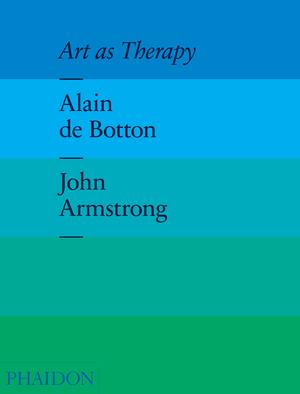

Phaidon (phaidon.com), one of my favorite publishers, has published a large, lavishly illustrated philosophy book. You read that correctly. Philosopher and prolific author, Alain de Botton (alaindebotton.com) has teamed up with fellow philosopher and art theorist John Armstrong to produce a book which asks what art is really for.
While your personal answer may vary, and the answer you get from curators and institutions may all conflict with yours and each others', de Botton's view in Art as Therapy is that it is here to help us understand life - our own lives, in particular. That art is a tool for figuring out how to manage your experiences and feelings by observing representations of the experiences and feelings of others, of seeing what others have deemed important, and finding context.
Yes, I'm oversimplifying: if you want to hear de Botton speak on it at length quite directly, read the introduction at Phaidon's article, 'Alain de Botton explains how we should use art', and follow the video link to the non-public video contained therein, where you can hear the author speed-talk through some high concepts about high art's earth-level uses.
The concept is a fun one. As someone who trained as a designer (architecture), took many art & architecture history classes, visits museums almost religiously, and creates fine art photographs which are occasionally sold at a gallery, I'm deep in the art stew. I have all sorts of mental references to call on about what art can be about and how it relates to things that aren't in the room (history, religious authorities, political changes, fads, art celebrities). A seemingly blank canvas can be something I interpret based on when/where it was made and who made it. Is a work flipping off the religious establishment by refusing to use its iconography, or kissing up by modeling the Virgin Mary on the daughter of the biggest donor to the institution commissioning it? I have enough context that I can make those kinds of associations. Meanwhile, my friends who studied other disciplines in school have no pre-baked context, and so some of them can't make heads or tails of a urinal that is signed and in the middle of a posh gallery. (I can see how this happens, though I think I'd know even if I hadn't taken art history that it's part of a cheeky joke about the art world and what it puts on pedestals.)
Since most people I know devote themselves to consumerist pastimes, and high art isn't something a consumer can buy on sale at a big box mall, the usefulness of art isn't necessarily apparent. Where shopaholics sometimes do connect with art conceptually is in a consuming tourist context: having something from a posh museum is a sign that you are cultured and posh. Let's buy museum-logo-purses! [insert weeping sounds here].
Yes, I do think art could offer something for everyone. I don't really mind that it doesn't - I'm pretty happy not watching cable tv, though I'm sure that could eventually offer me something if I gave it enough of my precious time, and that's a big cultural monolith of its own. I really am a to-each-their-own type (and with television, sometimes a better-you-than-me type).
de Botton and Armstrong offer a textbook with an alternative: maybe you can use fine art to better understand your own life, based on an immediate interpretation of the work, without needing to dig too deeply into the backstory of the art... unless you're into that, which is fine.
It's an interesting approach, and uses work that I wouldn't have thought of to illustrate its concepts, which are organized into topics that might be of use in practical life.
The book is published by an art and design publisher, and so I believe that fans of de Botton's who are also fans of art are most likely to buy this book, which provides a novel way of rethinking fine art, especially older (non-contemporary) art while casting off any formal, slightly uptight art education the reader may have had. It isn't earthshaking (though there's an implication that this approach is highly controversial to someone), but it's fun to try to re-interpret what art may be saying to you, modern person, that will make sense in the world you live in right now.
It would be nice if this book, and the related lectures which have been promoting it, find their way to a broad audience, so they can consider the role art COULD play in their lives.
text Copyright © 2014 A. E. Graves, other images copyright of their respective authors
(posted November 29, 2014, refreshed January 2019)